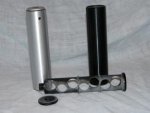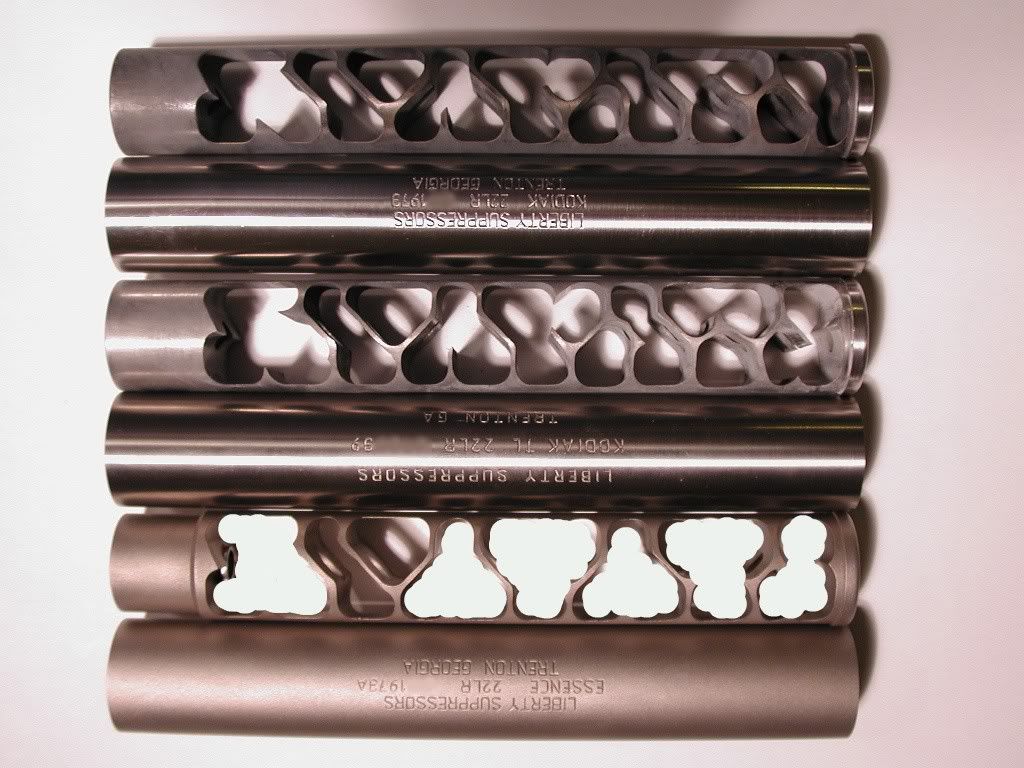Thanks Ben, appreciate the response. Since you are about to give this project your best and legally build a rifle that should serve you well for the rest of your life, I am going to be direct here. Before another opinion on your actually suppressor comes your way, mine, we need to revisit some of your thoughts.
An integral is built to be subsonic, period. It takes a specific, selected High Velocity round, in your case a .22 LR and is specifically tuned to bring THAT round to just under supersonic. Why, because all things being equal, ALL subsonic rounds are less accurate than supersonic rounds, , ALL subsonic rounds have less range than their supersonic variant, ALL subsonic rounds deliver less terminal force than the same components traveling at supersonic velocities. They, subsonics, are also almost always, more expensive, produced with powders that are filthy, and, just the opposite of what you stated, they are less accurate. They also, if store bought, are built to be subsonic in everything and therefor, in a rifle, truly perform poorly.
So, with that simple statement often read here at the Hide, no integral suppressor ever needs to shot subsonics, by definition. In fact, for many when we watch a smiling owner/builder shove a subsonic round in their integral and then are impressed at how "additionally" quiet their rifle now is, well we know.....we are watching an idiot. If their integral worked at all, the round was ALREADY subsonic...if it IS quieter when they use a subsonic, well it is because their can performs better with even LESS gas coming down the barrel. In short, their rifle is not ready for prime time. In fact, the vast majority of true integral makers make it perfectly clear that taping gas on a subsonic is a great way to destabilize the already puny subsonic velocity round to the point where the probability of a baffle strike, terrible particulate purging, increased leading, impudent terminal force along with zero chance for real accuracy is assured. You get the very best possible out of a .22lr round that is subsonic by starting with a high velocity round and, with a Chrony, get it as fast as possible without going supersonic. To do this you have to tap gas and that means a single hole in the barrel, properly placed. One hole, not the swiss cheese mess many employ. More on this later.
Sound in a firearm comes from five sources, there are no other, and if you attend to them one by one, you are done.
1. Blast
2. Supersonic Signature
3. Action noise
4. Terminal impact noise
5. Operator noise.
You are going to address the first three:
1. You want great blast suppression. That is all about your suppressor design.
2. You want to get the velocity below subsonic and when you do, you are DONE. There is no reason to build an integral that taps gas to subsonic and then ever need to send a subsonic down the barrel. In fact there is a whole host of reasons to never do it. Below super sonic is it....period....no more signature. From that point LOWER, all you get is less in everything, range, force, accuracy. And MORE particulate entrapment, leading, action issues (semi), etc. etc. etc.
3. You have selected a bolt action and, by definition, you have attended to action noise.
You cannot effect terminal impact noise in your build. You cannot effect operator noise in your build. Both can be potentially mitigated by your developing skills and techniques.
So, your design.
The quietest .22 LR true integrals recognize that standard profile and even most bull barrel profiles are simply not enough diameter to deliver excellent suppression results. This is especially true when making a short barrel integral rifle. I have never heard a standard barrel diameter integral or dedicated that sounds anything other than poorly. I never hear a standard bull barrel that achieve the level of suppression that is possible in an integral design as well. Almost without exception, the very best suppression in the .22 lr have barrel diameters are 1" OD minimum and require routing on the forearm to support the required diameter. Want the quietest integral you can build, with the shortest possible OAL? Plan on as large an ID as you can get.
If you are truly going to build an integral, you ARE going to tap gas to TUNE your selected round to be the best that it can be in the subsonic world. And, you will have to then know where and how.
If you just want to build a nice seamless profile barrel and DONT want to tap gas....and DO want to buy subsonics...that is a "dedicated" can. Nothing wrong with it, but it only has imo ONE application. That being, you want the OAL length of the barrel PLUS suppressor to be 16"+ . You get that, and you give up moving that can from one rig to another as a result. And......you are stuck buying subs that were made to be subsonic in pistols...as in...they flat out suck.
I applaud you effort to build can, excellent.
Here we go....no monocore that I have ever seen/heard does as good a job as properly fully formed conic faced baffles. Certainly not without being significantly longer and heavier when made of the same materials. This is especially true in a small caliber, small propellant gas system. First made in the 70's, monocores have been around a long long long time, there is nothing new about them. They do not represent a step forward in anything other than a system that, by design, does not require individual parts to be assembled...and in large rifle calibers...welded. For decades, high volume, high cycle rate systems used stacked, un-welded assemblies of cones and spacers all set in their outside envelope. They allowed the machinist to concentrate on the front face of the baffle, where suppression efficiency is found. When made out of the proper materials, the whole armature could be broken down and dip cleaned in caustic chemicals that would literally dissolve the majority of monocores found today. Why? Because most monocores use so much materials that they must be made out of lighter materials. Aside from that there is a whole host of reasons why monocores lead to particulate entrapment, hot spots, leading and...if it matters...an almost impossible task of repair. Monocore designs can cut waves, flats, bored offsets and redirects...they cannot cut cones. There is a whole science about the pressures to be found in the cascading chambers. Maintaining that pressure to insure maximum propellant purge is completely lost in the vast, vast majority of monocore designs. Entrapment is the rule it seems, they MUST by design come out to be cleaned.
Go cones, properly spaced chambers. All the most quietest, accurate, lightest, most serviceable suppressors use them. I, like others, want all our cans to be sealed, even our .22lr. We shoot plated .22lr and put 10s of thousands of rounds through and never have an issue. But, in a .22, you can go loose assembly and avoid the expense and skill required to weld them all in place. Avoiding THAT is why monocores exist.
It may not be the best utilization of your desire to do solid form computing....but in the end you will have #1 and #2 to the best that is possible.
Study cones and their placement. They are all over the web. Like I said, its another opinion.










